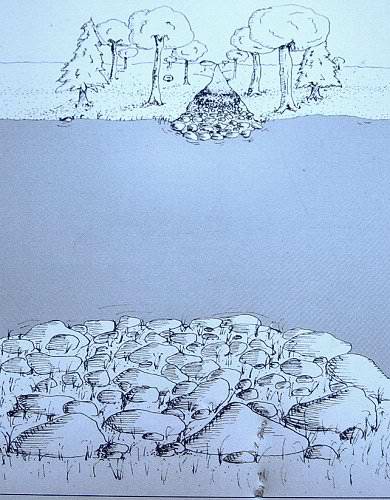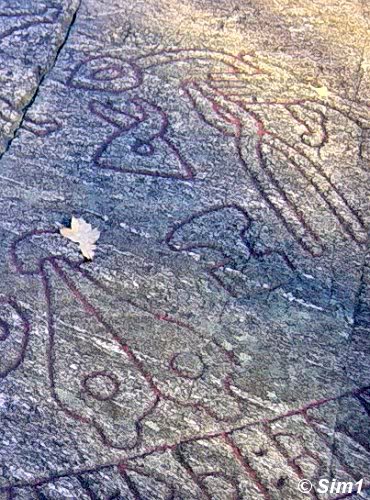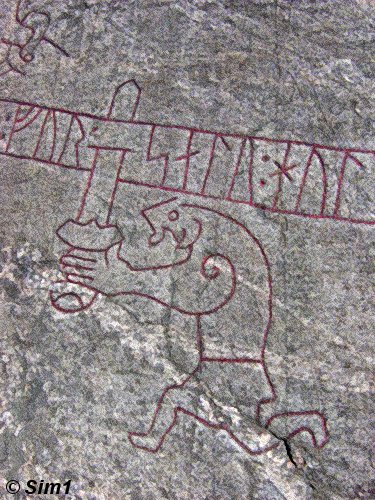| My pages about the area around Lake Mälaren |
| My travel stories | My photo impressions | ||
| Anundshög | Stingsmossen | ||
| Eskilstuna | Strängnäs | ||
| Fiholm | Sundbyholm | ||
| Gripsholm | Västerås | ||
| Häljesta Rock Carvings | Vallby Open Air Museum | ||
| Mariefred | Örebro | ||
| Sigurdsristningen |

I guess it is time that I write a bit more about 'my' area of Sweden: the area around Lake Mälaren! Mälaren is the third largest lake in Sweden and it also the area that I now call my home. I have been living here for approximately 15 years; to be exact, from the first day that I moved to Sweden. And only 5 minutes walk from my house you can find an important runic carvings. It is quite special, as it is not a runic stone, but instead carving made into the rocks.
All the photos in the collage below are clickable, so you can view the larger photo.
Sigurdsristningen / The Sigurds Carving
Sweden

Sigurdsristning
The Sigurdsristning is a special place with a lot of history. You can see it on the side of a quiet road, somewhere in between the trees. A little sign tells you where it is. And when you climb up the hillside you will see a huge rock with carved pictures surrounded by runic inscriptions. But what you feel is history, and lots of it. I find it an amazing place. It feels special to be here, where so many centuries ago someone was telling a story of a distinguished Viking family, by making these carvings in these rocks.
It's an important historic place, but it is unprotected, it is just 'there' in the woods. And maybe that makes it even more special. I always feel peaceful when I am here, I don't know why, I just feel at ease. The carvings are only a 5 minutes walk from my house. I don't go here often though. Maybe it is because I want to keep it 'special', a place to visit so now and than and have that great feeling to connect with history.

The road to Sigurdsristning
The Sigurdsristningen are close to Sundbyholm Castle. Driving from Eskilstuna in the direction of Sundbyholm, just before you arrive at the castle, there is a little road to the right which brings you to the carvings. The road goes down the hill, over a bridge, and on the right side of the road is the rock with the carvings. You have to pay attention to find it though, there is only a very small sign on the side of the road telling you where the carvings are. Nowadays there is a little parking area, just past the Sigurdsristningen, on the left side of the road.
Everyone in this area calls it "Sigurdsristningen" (as you can see on the sign) or translated "the Sigurd Carving". But it is also known under the name "the Ramsund carving", named after the river. But I don't think many locals would know what you mean when you ask directions to the Ramsund carving as it is not commonly used around here.

Sigurdsristning
The landscape was much different in the times of the Vikings, because the water level was much higher in those days. The lake covered much of the countryside south of Sundbyholm. So this rock would actually be at the side of the river, not high above an adjecent road, as it is today.
The explanation for this difference in water level goes back to the ice-age. The ice has covered this part of Sweden with a thick layer of ice, clinging in the soil beneath it because of its heavy weight. But now without the heavy weight of the ice, the soil got a chance to regain its volume again, and has slowly rissen up. You can compare it to a sponge effect.
So at the end of the Viking age (mid-11th century), the flat rock with the engraved Sigurd Carving lay by the edge of the Ramsundet (or Ramsund) channel. This channel was not only an important link, but it was also a very busy means of communication between Lake Mälaren and what is today known as Kafjärden, a bay in Mälaren. The site of the carving was a central meeting point for travellers
In the photo above you can see the left part of the Sigurdsristningen.


The bridge at Sigurdsristning
The custom of carving runes on erected stones and exposed bedrock became common around 1000 AD. It became common in the eleventh century to build bridges for the souls of the dead and to mention them in adjacent runic inscriptions. And this explains why there are runic inscriptions next to a bridge here at Sundbyholm. The Sigurdsristning is special though, because besides runic inscriptions, there is a whole saga told in pictures inside the inscriptions.
It was costly in these times to portray a picture epos such as this. And one can only imagine how costly it would have been to build this bridge. The person who had them made must have been wealthy. The inscriptions give some insight on who she was. The text reads as follows:
"Sigrid, Alrik's mother, Orm's daughter, made this bridge for her husband Holmger's, Sigröd's father's, soul."
The text explains that Sigrid had a bridge built for her dead husband's soul. This bridge must have been quite a masterpiece both tecnically and economically. Ramsundet was wide and rather deep which means that the bridge was a high one and not just a paved ford. They don't know what the bridge used to look like, so in there is no example of the bridge drawn on this picture.
There is a rubble of big boulders left here, which most likely was part of the bridgehead at the time. And standing here, you can imagine how the bridge must have crossed to the other side. Below you nowadays is a small road, but in the 11th century this was a wide river. The river is still here, but on the other side of the road, and very small; more like a small creek.
A considerable amount of rune stones were erected by single woman, or by woman along with several men. These were often the widow and sons of the dead, but sometimes also sisters and brothers. Interesting to know that it is almost only in Öland and in the Lake Mälaren area that women seemed to have raised stones after their male relatives.


It's time to take a look at the whole carvings. It is best illustrated by this drawing of the rock carvings. This will give you a better idea off what you are seeing in all the pictures of the rock carvings on this page and give you an idea what the whole carvings looks like.
The Sigurd Carving has dragons on the outside, which are filled with decorations and runes. On the inside of the dragon (but with a snake-like body) you can see a lot of small pictures. The runic inscription on the Sigurds Ristning does not have any connection with the pictures that are inside it. These pictures tell a saga and can been seen as one of the first Nordic "cartoons".
The saga was well known by the time they were cut and needed no explanation to the people. The saga tells of a man named Sigurd Fafnesbane (Sigurd the Dragonslayer). The saga is both ancient and widespread throughout Europe. I will write part of the saga and show the pictograms further below on this page.
The Sigurd Saga originates from the Icelandic Eddan, a collection of Godly and heroic poems with roots way back in the 9th century. The Saga is a mix of Frankish, Burgundy, Gothic, Icelandic and Anglo-saxon material from different times.

Otter
"Otter was one of Rodmar's three sons. When he fished for salmon, he was wont to take on the shape of an otter. On one such occassion, the Æsir (Norse gods): Loki, Hörnir, and Odin happened by. Otter was killed by a stone that Loki threw at him. Later that same evening, the Æsir went to Rodmar and showed him their prey. Rodmar (the father) became angry. He demanded that the Æsir fill the otter skin with gold to atone for their crime."
"Loki went to the Andvara rapids and used his net to catch the dwarf Andvari, who had taken on the shape of a pike. The dwarf purchased his freedom with all the gold he owned except for one gold ring. When Loki ripped the ring from his hand, the dwarf spoke a curse over all who would come in contact with the gold. Once the father Rodmar had received the gold, he did not want to share it with his other two sons, Fafnir and Regin."

Fafnir the snake
"Fafnir became enraged and killed his father to get at the gold. Thereafter, Fafnir took the shape of a snake and brooded atop the gold at a place called Gnitaheden."
The snake is the part that goes all around the ristning and this is the head that you can see on the right side of the carvings. The snake is Fafnir, son of Rodmar. In the lower part of his snake body is the Runic inscription.


The tools of Regin
"Regin, who was a smith, wanted a share of the patrimony and planned to seize the gold through trickery. He brought Sigurd, who had earlier become his foster son, into his plans. He forged a razor-sharp sword, named Gram, for Regin."
In this close up of the Sigurdsristning you can see the bellows, anvil, hammer, a pair of tongs and a fire which Regin used to forge the sword. The great part of this detail of the Ristning is that it is one of the first pictures of tools; giving it a big industrial historic value.


Sigurd killing Fafnir
"Urged on by his foster father Regin, Sigurd dug a hole at Gnitaheden where Fafnir, in the shape of a snake, usually slithered his way down to the lake to drink. When Fafnir entered the trap, Sigurd stabbed him through the heart with his sword, Gram. Fafnir died and Sigurd was then given the name Fafnesbane (the Bane of Fafnir)"
In the carving you can see Sigurd killing Fafnir by sticking the sword into the snake/dragon body (=Fafnir).

Sigurd putting his finger in his mouth
"Regin tells Sigurd to roast his brother/dragons heart, so that his spirit can live on. Sigurd accidentally burnt himself while roasting Fafnir's heart over an open fire. He put his fingers in his mouth and got Fafnir's blood on his tongue. Instantly he could understand birdsong.
In this detail of the Sigurdsristning you can see Sigurd putting his fingers in his mouth and get Fafnir's blood on his tongue (photo left). Also clearly visible are the skewer, heart and fire. You can see the total scene in the photo below.
roasting Fafnir's heart over an open fire

the birds
"Sigurd hears the two birds talk about him and Regin. They talk about how Sigrid has been tricked. Regin wants to eat the heart to get the power that it has. The birds warned Sigurd. Regin was plannning to kill him, partly to revenge his brother Fafnir, partly so that he would have the treasure to himself. The birds adviced Sigurd to kill Regin."

Regin and his cut off head
"Sigurd sought out Regin and cut off his head so that he would escape his thoughts in the future."
In this part of the carvings you can see Regin with his cut off head laying to the right side of him.

the horse Grani
"Sigurd then travelled to Fafnir's home, where he found the disputed gold and many precious objects. He loaded the treasures onto his horse Grani. The horse was a gift from the god Oden, and Grani is a direct descendent of Odin's own horse Sleipnir. However, Grani refused to move from his stall before Sigurd himself mounted."
In the photo you see the horse Grani, and it is clearly visable how he is tied to a tree with the gold treasure on its back.

Sigurdsristningen
A final photo of the sigurdsristningen that I took on my walk on a lovely sunny autumn day in september 2019. The rock is quick large, and taking photos of the total rock isn't that easy. Not really the best of light today either, so I guess it is an excellent excuse to walk down here again soon, to give it a new try :-)
As a side note: it might be nice to know that there are quite a few nice walking trails in the area. One of them is just across the street, crossing the bridge over the little creek. It will lead you through a pasture, which is a nature area. During part of the season you can find cows grazing here, and even see them calf in this pasture. The purpose of this area is to keep it as natural as possible, so there are trees, and large bushes, lots of wildflowers, and high grass. And through it goes a small trail, that will bring you past the "Tegelslagerstugan", which is an old cottage, towards the Sundbyholm Castle and Sundbyholm harbour.
Anyway, I just HAD to drop by the Sigurdsristningen today for a visit, inspired by writing this page. Digging into the viking history is quite fascinating, and the rune stones make it so near and imaginable. So I had to drop by once more to soak up the atmosphere and take a few more photos. One day for sure I will wite a page focussing on the Viking era, but for now let me link to some of my pages where you can find some more photos of this part of history:
• Anundshög, with two very large stone-ships and the largest burial mound in Sweden
• Gripsholm, with a very interesting rune stone (Ingvar runestones)
• Rök, the most famous of rune stones
• If you are interested in viking history I can warmly recommend a visit to Swedish History Museum / Historiska museum in the heart of Stockholm as well.
Simone & Åke, Sigurdsristningen, Sweden

It would be great to hear from you!
You can reach me by sending me an Email.
Or leave a comment / reaction in the box below.
You can also follow me on Facebook: Sim1 around the World Blog
:-) Simone